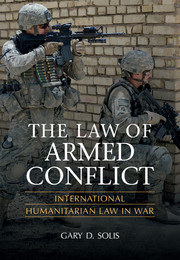Book contents
- Frontmatter
- Contents
- Table of Cases
- Table of Treaties
- Foreword
- Preface
- Acknowledgments
- LAW OF ARMED CONFLICT: INTERNATIONAL HUMANITARIAN LAW IN WAR
- LAW OF ARMED CONFLICT AND INTERNATIONAL HUMANITARIAN LAW: A FRAMEWORK
- LAW OF ARMED CONFLICT AND INTERNATIONAL HUMANITARIAN LAW: BATTLEFIELD ISSUES
- 9 Obedience to Orders, the First Defense
- 10 Command Responsibility and Respondeat Superior
- 11 Ruses and Perfidy
- 12 Torture
- 13 Rules of Engagement
- 14 Targeting
- 15 Attacks on Cultural Property
- 16 The 1980 Certain Conventional Weapons Convention
- 17 Gas, Biological, and Chemical Weapons Treaties
- References
- Index
- References
16 - The 1980 Certain Conventional Weapons Convention
from LAW OF ARMED CONFLICT AND INTERNATIONAL HUMANITARIAN LAW: BATTLEFIELD ISSUES
- Frontmatter
- Contents
- Table of Cases
- Table of Treaties
- Foreword
- Preface
- Acknowledgments
- LAW OF ARMED CONFLICT: INTERNATIONAL HUMANITARIAN LAW IN WAR
- LAW OF ARMED CONFLICT AND INTERNATIONAL HUMANITARIAN LAW: A FRAMEWORK
- LAW OF ARMED CONFLICT AND INTERNATIONAL HUMANITARIAN LAW: BATTLEFIELD ISSUES
- 9 Obedience to Orders, the First Defense
- 10 Command Responsibility and Respondeat Superior
- 11 Ruses and Perfidy
- 12 Torture
- 13 Rules of Engagement
- 14 Targeting
- 15 Attacks on Cultural Property
- 16 The 1980 Certain Conventional Weapons Convention
- 17 Gas, Biological, and Chemical Weapons Treaties
- References
- Index
- References
Summary
Introduction
Two multinational treaties, particularly, have a potential impact on combatants. Violation of either the 1954 Hague Convention for the Protection of Cultural Property (Chapter 15) or the 1980 Convention on Certain Conventional Weapons (CCW) could lead to war crimes charges against soldiers in the field. This chapter examines the CCW, the full title of which is the “Convention on Prohibitions or Restrictions on the Use of Certain Conventional Weapons Which May be Deemed to be Excessively Injurious or to Have Indiscriminate Effects.” In the maze of law of armed conflict/international humanitarian law (LOAC/IHL) acronyms, do not confuse the CCW, the Certain Conventional Weapons treaty, with the CWC, the Chemical Weapons Convention (Chapter 17).
Antipersonnel landmines, white phosphorus munitions, laser weapons, flamethrowers, cluster bombs, improvised explosive devices (IEDs) – these weapons and munitions are all subjects of, or are implicated by, the CCW, which seeks to define their lawful and unlawful uses.
Restrictions on weapons are hardly a modern conception. “The epic poem Mahabharatha, [200 b.c.–200 a.d.] forbids the use of ‘hyper-destructive’ weapons: ‘Arjuna, observing the laws of war, refrained from using the pasupathastra…because when the fight was restricted to ordinary conventional weapons, the use of extraordinary or unconventional types was not even moral, let alone in conformity with religion or the recognized rules of warfare.” We twenty-first-century mortals may not know what the pasupathastra was but, out of humanitarian concerns, it went unused in combat.
- Type
- Chapter
- Information
- The Law of Armed ConflictInternational Humanitarian Law in War, pp. 577 - 599Publisher: Cambridge University PressPrint publication year: 2010



